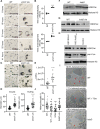Role of epigenetics in unicellular to multicellular transition in Dictyostelium
- PMID: 33947439
- PMCID: PMC8094536
- DOI: 10.1186/s13059-021-02360-9
Role of epigenetics in unicellular to multicellular transition in Dictyostelium
Abstract
Background: The evolution of multicellularity is a critical event that remains incompletely understood. We use the social amoeba, Dictyostelium discoideum, one of the rare organisms that readily transits back and forth between both unicellular and multicellular stages, to examine the role of epigenetics in regulating multicellularity.
Results: While transitioning to multicellular states, patterns of H3K4 methylation and H3K27 acetylation significantly change. By combining transcriptomics, epigenomics, chromatin accessibility, and orthologous gene analyses with other unicellular and multicellular organisms, we identify 52 conserved genes, which are specifically accessible and expressed during multicellular states. We validated that four of these genes, including the H3K27 deacetylase hdaD, are necessary and that an SMC-like gene, smcl1, is sufficient for multicellularity in Dictyostelium.
Conclusions: These results highlight the importance of epigenetics in reorganizing chromatin architecture to facilitate multicellularity in Dictyostelium discoideum and raise exciting possibilities about the role of epigenetics in the evolution of multicellularity more broadly.
Keywords: Acetylation; Dictyostelium discoideum; Epigenetics; HDAC; Methylation; Multicellularity; hdaD; smcl1; srfA.
Conflict of interest statement
The authors have no competing interests.
Figures





References
-
- Grosberg RK, Strathmann RR. The evolution of multicellularity: a minor major transition? Annu Rev Ecol Evol Syst. 2007;38:621–654.
-
- King N. The unicellular ancestry of animal development. Dev Cell. 2004;7:313–325. - PubMed
-
- Rokas A. The origins of multicellularity and the early history of the genetic toolkit for animal development. Annu Rev Genet. 2008;42:235–251. - PubMed
Publication types
MeSH terms
Substances
Grants and funding
LinkOut - more resources
Full Text Sources
Other Literature Sources
Molecular Biology Databases

